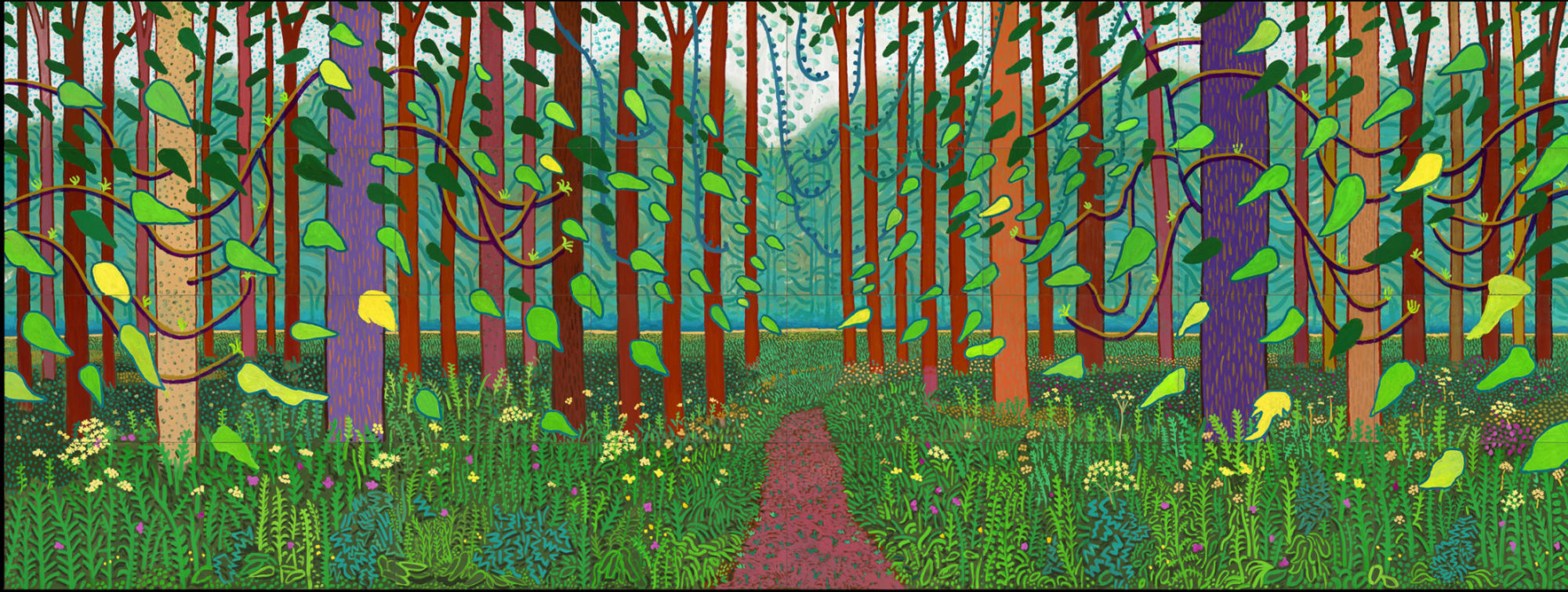
The Van Gogh Museum recently opened an exhibition on David Hockney and Vincent van Gogh: The Joy of Nature. Even though Van Gogh and Hockney lived a century apart, a lot of parallels can be drawn between their work. What did nature mean to both of them?
Van Gogh believed that an artist had to truly know and understand nature, and wrote in a letter to his brother Theo that ‘In all of nature, in trees for instance, I see expression and a soul, as it were.’ His landscape paintings are characterized by expressive brushwork and the use of bright colors as for example seen in Wheat Field with Cypresses. Even though he lived in Paris for some time, he spent the last years of his life in the Provence, where he felt much more at peace. He painted over two thousand landscapes, varying from the Dutch countryside to the radiating sunflower fields in France.

David Hockney’s The Arrival of Spring in Woldgate, East Yorkshire consist of 32 oil painted canvases. It depicts a colorful landscape with trees and plants painted in bright vibrant colors. This painting shows us Hockney in a nutshell, who is also known for his bold use of colors and sizable artworks. Hockney has said to have been inspired by Van Gogh’s work. He uses the same pointillistic painting style Van Gogh used to capture movement in his works. David Hockney grew up in the town of Bradford, England, a smoky industrial town were everything was covered in black industrial smog. He moved to Los Angeles later in life where he only knew one season: summer. In 2004, he returned to England to settle in East Yorkshire, where the nature around him was constantly changing. This was what led to his great interest in landscape painting and thus he started painting en plein air (‘outdoor painting’). Hockney, 81 years old and still painting every day, says that he never gets bored of nature and continues to feel inspired by it.
Nature has proved important for both Hockney and Van Gogh; it inspired some of their greatest paintings and provided them with a stimulating work environment. To find out more about what nature meant to Hockney and van Gogh, visit the exhibition Hockney – Van Gogh: The Joy of Nature at the Van Gogh Museum.

The exhibition Hockney – Van Gogh: The Joy of Nature is on display until May 26th, 2019 at the Van Gogh Museum.
About the artworks
Picture 1
Vincent van Gogh (1853 – 1890),
Wheat Field with Cypresses, Saint-Rémy-de-Provence, June-July 1889
Pencil, reed pen and pen and ink, on paper
47.1 cm x 62.3 cm
Van Gogh Museum, Amsterdam
Credits: Van Gogh Museum, Amsterdam (Vincent van Gogh Foundation)
Picture 2
Žilvinas Kempinas
David Hockney (1937 -),
The Arrival of Spring in Woldgate, East Yorkshire, 2011
Oil on 32 canvases
91.4 × 121.9 cm each, 365.8 × 975.4 cm overall
Centre Pompidou, Paris. Musée national d’art moderne – Centre de création industrielle
The Van Gogh Museum recently opened an exhibition on David Hockney and Vincent van Gogh: The Joy of Nature. Even though Van Gogh and Hockney lived a century apart, a lot of parallels can be drawn between their work. What did nature mean to both of them?
Van Gogh believed that an artist had to truly know and understand nature, and wrote in a letter to his brother Theo that ‘In all of nature, in trees for instance, I see expression and a soul, as it were.’ His landscape paintings are characterized by expressive brushwork and the use of bright colors as for example seen in Wheat Field with Cypresses. Even though he lived in Paris for some time, he spent the last years of his life in the Provence, where he felt much more at peace. He painted over two thousand landscapes, varying from the Dutch countryside to the radiating sunflower fields in France.

David Hockney’s The Arrival of Spring in Woldgate, East Yorkshire consist of 32 oil painted canvases. It depicts a colorful landscape with trees and plants painted in bright vibrant colors. This painting shows us Hockney in a nutshell, who is also known for his bold use of colors and sizable artworks. Hockney has said to have been inspired by Van Gogh’s work. He uses the same pointillistic painting style Van Gogh used to capture movement in his works. David Hockney grew up in the town of Bradford, England, a smoky industrial town were everything was covered in black industrial smog. He moved to Los Angeles later in life where he only knew one season: summer. In 2004, he returned to England to settle in East Yorkshire, where the nature around him was constantly changing. This was what led to his great interest in landscape painting and thus he started painting en plein air (‘outdoor painting’). Hockney, 81 years old and still painting every day, says that he never gets bored of nature and continues to feel inspired by it.
Nature has proved important for both Hockney and Van Gogh; it inspired some of their greatest paintings and provided them with a stimulating work environment. To find out more about what nature meant to Hockney and van Gogh, visit the exhibition Hockney – Van Gogh: The Joy of Nature at the Van Gogh Museum.

The exhibition Hockney – Van Gogh: The Joy of Nature is on display until May 26th, 2019 at the Van Gogh Museum.
About the artworks
Picture 1
Vincent van Gogh (1853 – 1890),
Wheat Field with Cypresses, Saint-Rémy-de-Provence, June-July 1889
Pencil, reed pen and pen and ink, on paper
47.1 cm x 62.3 cm
Van Gogh Museum, Amsterdam
Credits: Van Gogh Museum, Amsterdam (Vincent van Gogh Foundation)


